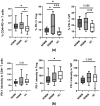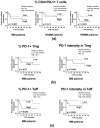Inappropriate Expression of PD-1 and CTLA-4 Checkpoints in Myeloma Patients Is More Pronounced at Diagnosis: Implications for Time to Progression and Response to Therapeutic Checkpoint Inhibitors
- PMID: 36982802
- PMCID: PMC10056286
- DOI: 10.3390/ijms24065730
Inappropriate Expression of PD-1 and CTLA-4 Checkpoints in Myeloma Patients Is More Pronounced at Diagnosis: Implications for Time to Progression and Response to Therapeutic Checkpoint Inhibitors
Abstract
Multiple myeloma (MM) is a hematologic malignancy characterized by severely profound immune dysfunction. Therefore, the efficacy of drugs targeting the immune environments, such as immune checkpoint inhibitors (ICIs), is of high clinical importance. However, several clinical trials evaluating ICIs in MM in different therapeutic combinations revealed underwhelming results showing a lack of clinical efficacy and excessive side effects. The underlying mechanisms of resistance to ICIs observed in the majority of MM patients are still under investigation. Recently, we demonstrated that inappropriate expression of PD-1 and CTLA-4 on CD4 T cells in active MM is associated with adverse clinical outcomes and treatment status. The aim of the current study was to determine the usefulness of immune checkpoint expression assessment as a predictive biomarker of the response to therapeutic inhibitors. For this purpose, along with checkpoint expression estimated by flow cytometry, we evaluated the time to progression (TTP) of MM patients at different clinical stages (disease diagnosis and relapse) depending on the checkpoint expression level; the cut-off point (dividing patients into low and high expressors) was selected based on the median value. Herein, we confirmed the defective levels of regulatory PD-1, CTLA-4 receptors, and the CD69 marker activation in newly diagnosed (ND) patients, whereas relapsed/refractory patients (RR) exhibited their recovered values and reactivity. Additionally, substantially higher populations of senescent CD4+CD28- T cells were found in MM, primarily in NDMM subjects. These observations suggest the existence of two dysfunctional states in MM CD4 T cells with the predominance of immunosenescence at disease diagnosis and exhaustion at relapse, thus implying different responsiveness to the external receptor blockade depending on the disease stage. Furthermore, we found that lower CTLA-4 levels in NDMM patients or higher PD-1 expression in RRMM patients may predict early relapse. In conclusion, our study clearly showed that the checkpoint level in CD4 T cells may significantly affect the time to MM progression concerning the treatment status. Therefore, when considering novel therapies and potent combinations, it should be taken into account that blocking PD-1 rather than CTLA-4 might be a beneficial form of immunotherapy for only a proportion of RRMM patients.
Keywords: CTLA-4; PD-1; clinical response; immune checkpoint inhibitors; multiple myeloma; time to progression.
Conflict of interest statement
The authors declare no conflict of interest.
Figures






Similar articles
-
Deregulated Expression of Immune Checkpoints on Circulating CD4 T Cells May Complicate Clinical Outcome and Response to Treatment with Checkpoint Inhibitors in Multiple Myeloma Patients.Int J Mol Sci. 2021 Aug 27;22(17):9298. doi: 10.3390/ijms22179298. Int J Mol Sci. 2021. PMID: 34502204 Free PMC article.
-
Emerging therapies in Multiple Myeloma: Leveraging immune checkpoint inhibitors for improved outcomes.Hum Antibodies. 2025 May;33(1-2):10-24. doi: 10.1177/10932607241301699. Epub 2025 Jan 15. Hum Antibodies. 2025. PMID: 39973812 Review.
-
[Expression and Significance of PD-1, PD-L1 and CTLA-4 in the Bone Marrow of Patients with Multiple Myeloma].Zhongguo Shi Yan Xue Ye Xue Za Zhi. 2022 Dec;30(6):1803-1809. doi: 10.19746/j.cnki.issn.1009-2137.2022.06.027. Zhongguo Shi Yan Xue Ye Xue Za Zhi. 2022. PMID: 36476907 Chinese.
-
The Next Immune-Checkpoint Inhibitors: PD-1/PD-L1 Blockade in Melanoma.Clin Ther. 2015 Apr 1;37(4):764-82. doi: 10.1016/j.clinthera.2015.02.018. Epub 2015 Mar 29. Clin Ther. 2015. PMID: 25823918 Free PMC article. Review.
-
Disruption of CTLA-4 expression on peripheral blood CD8 + T cell enhances anti-tumor efficacy in bladder cancer.Cancer Chemother Pharmacol. 2019 May;83(5):911-920. doi: 10.1007/s00280-019-03800-x. Epub 2019 Mar 8. Cancer Chemother Pharmacol. 2019. PMID: 30848330
Cited by
-
Checkpoint inhibition in hematologic malignancies.Front Oncol. 2023 Oct 17;13:1288172. doi: 10.3389/fonc.2023.1288172. eCollection 2023. Front Oncol. 2023. PMID: 37920162 Free PMC article. Review.
-
Integrating p53-associated genes and infiltrating immune cell characterization as a prognostic biomarker in multiple myeloma.Heliyon. 2024 Apr 20;10(8):e30123. doi: 10.1016/j.heliyon.2024.e30123. eCollection 2024 Apr 30. Heliyon. 2024. PMID: 38699735 Free PMC article.
-
Mesenchymal stromal cells in bone marrow niche of patients with multiple myeloma: a double-edged sword.Cancer Cell Int. 2025 Mar 26;25(1):117. doi: 10.1186/s12935-025-03741-x. Cancer Cell Int. 2025. PMID: 40140850 Free PMC article. Review.
-
Genetic, epigenetic, and molecular determinants of multiple myeloma and precursor plasma cell disorders: a pathophysiological overview.Med Oncol. 2025 Jun 3;42(7):234. doi: 10.1007/s12032-025-02807-0. Med Oncol. 2025. PMID: 40459694 Review.
-
Progress of immune senescence in multiple myeloma treatment resistance.Discov Oncol. 2025 Mar 26;16(1):402. doi: 10.1007/s12672-025-02136-8. Discov Oncol. 2025. PMID: 40138127 Free PMC article. Review.
References
-
- Favaloro J., Liyadipitiya T., Brown R., Yang S., Suen H., Woodland N., Nassif N., Hart D., Fromm P., Weatherburn C., et al. Myeloid derived suppressor cells are numerically, functionally, and phenotypically different in patients with multiple myeloma. Leuk. Lymphoma. 2014;55:2893–2900. doi: 10.3109/10428194.2014.904511. - DOI - PubMed
-
- Brown R.D., Pope B., Murray A., Esdale W., Sze D.M., Gibson J., Ho P.J., Hart D., Joshua D. Dendritic cells from patients with myeloma are numerically normal but functionally defective as they fail to up-regulate CD80 (B7-1) expression after huCD40LT stimulation because of inhibition by transforming growth factor-β1 and interleukin-10. Blood. 2001;98:2992–2998. doi: 10.1182/blood.V98.10.2992. - DOI - PubMed
-
- Bryant C., Suen H., Brown R., Yang S., Favaloro J., Aklilu E., Gibson J., Ho P.J., Iland H., Fromm P., et al. Long-term survival in multiple myeloma is associated with a distinct immunological profile, which includes proliferative cytotoxic T cell clones and a favourable Treg/Th17 balance. Blood Cancer J. 2013;3:e148. doi: 10.1038/bcj.2013.34. - DOI - PMC - PubMed
MeSH terms
Substances
Grants and funding
LinkOut - more resources
Full Text Sources
Medical
Research Materials

